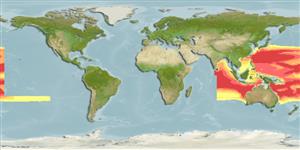>
Scombriformes (Mackerels) >
Bramidae (Pomfrets)
Etymology: Brama: Old French, breme, bresme = a fresh water fish; 1460 (Ref. 45335); pauciradiata: Named for its having a relatively few dorsal and anal fins.
More on authors: Moteki, Fujita & Last.
Environment: milieu / climate zone / depth range / distribution range
Écologie
marin; saumâtre; profondeur 80 - 550 m (Ref. 13363). Tropical
Indo-Pacific: Australia and Coral Sea.
Taille / Poids / Âge
Maturity: Lm ? range ? - ? cm
Max length : 8.2 cm SL mâle / non sexé; (Ref. 13363)
Life cycle and mating behavior
Maturité | Reproduction | Frai | Œufs | Fécondité | Larves
Moteki, M., K. Fujita and P. Last, 1995. Brama pauciradiata, a new bramid fish from the seas off tropical Australia and the central Pacific Ocean. Jap. J. Ichthyol. 41(4):421-427. (Ref. 13363)
Statut dans la liste rouge de l'IUCN (Ref. 130435: Version 2024-1)
Menace pour l'homme
Harmless
Utilisations par l'homme
Outils
Articles particuliers
Télécharger en XML
Sources Internet
Estimates based on models
Preferred temperature (Ref.
123201): 12.7 - 21.7, mean 18.3 °C (based on 91 cells).
Phylogenetic diversity index (Ref.
82804): PD
50 = 0.5039 [Uniqueness, from 0.5 = low to 2.0 = high].
Bayesian length-weight: a=0.01122 (0.00514 - 0.02450), b=3.04 (2.87 - 3.21), in cm total length, based on all LWR estimates for this body shape (Ref.
93245).
Niveau trophique (Ref.
69278): 3.5 ±0.6 se; based on size and trophs of closest relatives
Résilience (Ref.
120179): Haut, temps minimum de doublement de population inférieur à 15 mois (Preliminary K or Fecundity.).
Fishing Vulnerability (Ref.
59153): Low vulnerability (10 of 100).
